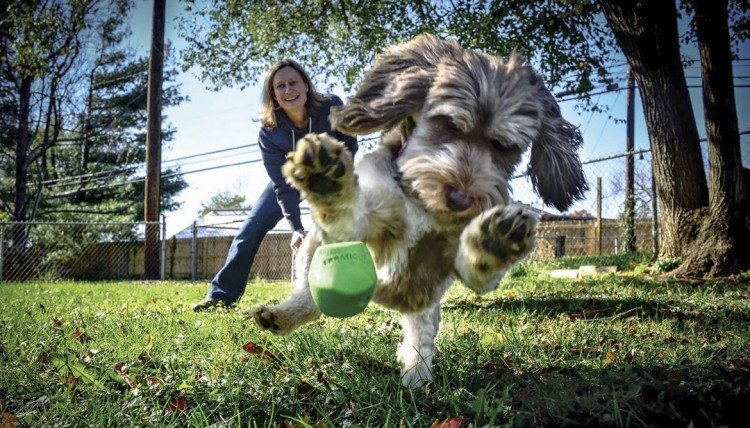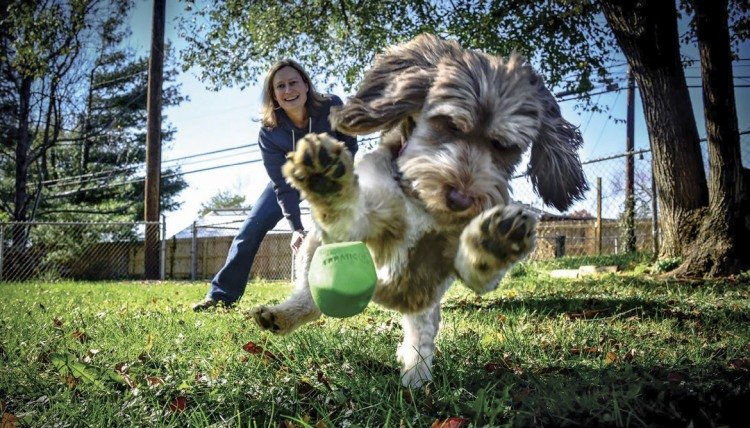
Working from home has many benefits, particularly if you have a dog. You can walk or cuddle her any time you want, and you don’t have to rush home to give her a bathroom break. But when you have a puppy, keeping her occupied so you can get some actual work done can be exhausting—I know because I have one.
Among other things, Josie, my nine-month-old German Shepherd/Labrador mix, whines and barks to get my attention when I’m on the phone, which can make business calls a little less professional than I’d like them to be. Through trial and error and with professional help, I’ve developed a short list of strategies to keep her entertained.
1. Create a schedule. Dogs love routine, so having a daily schedule keeps them on a more even keel, according to trainer John Imler, owner of Top Dog Training in Louisville, Ky. He suggests rotating outside play, inside quiet time, bathroom break, crate nap and so on until dinner and bedtime. “Usually, that wears a puppy out on a daily basis, and you end up conditioning an adolescent dog to learn to be calm next to you while [you’re] working,” Imler said. “They know a trip outside is coming.”
2. Be Active. Emma Grigg, CAAB and author of The Science Behind a Happy Dog: Canine Training, Thinking and Behaviour, says there are two ways to keep a puppy entertained: active and passive. Most dogs, especially young dogs and active breeds, need a little more activity to keep them entertained, says Grigg. Dogs need to burn off a certain amount of energy every day, and making sure your dog gets enough exercise is crucial. “If they don’t get the opportunity to do this through walks, dog park time, games of fetch and so forth, they will often find less-appealing ways to channel that energy,” like eating your couch, Grigg points out.
GET THE BARK NEWSLETTER IN YOUR INBOX!
Sign up and get the answers to your questions.

Janet and Penelope by Katie Joya
Grigg advises those who work from home to start and end their day with a good walk, even if they have a fenced yard. “While [a play area] is great for dogs, it still isn’t the same as a walk off-property,” she said. Consult your veterinarian on how much exercise is appropriate for your puppy’s age. Another plus: these walks may help you be more productive and creative as well.
3. Train throughout the day. Griggs also recommends two to three short training sessions (5 to 10 minutes) each day, combined perhaps with changes to the way you interact with the dog, which she says can usually result in huge improvements in a relatively short amount of time. Teaching your dog relaxation protocols—to settle, for example—is another useful skill. She recommends Emily Larlham’s Kikopup tutorial “Capturing Calmness” (available on YouTube), which she says is simple and straightforward. Eventually, your dog will understand when it’s time to settle down and relax while you participate in that important conference call. “I teach all my dogs a ‘go to your bed’ cue, and reward them for doing so,” Grigg says. “I make a point of sometimes rewarding them for being calmly settled on their bed, even when I haven’t asked them to do this. I am a firm believer in rewarding behavior that I like to increase the chances of these behaviors happening again.”
However, be careful not to reinforce bad behavior. If your dog is pawing at you or whining for your attention (Josie, I’m looking at you), don’t give her what she’s seeking. “If the only time the puppy gets your attention —positive or negative—is when she barks at you, paws your leg or whines, this approach is working for her, and she will continue to repeat these behaviors,” Grigg observes. “Instead, ignore those behaviors and reward her when she is calm. This will be challenging at first, but in my experience, young dogs figure this out pretty quickly.”
4. Get some toys. Passive entertainment—aka toys —is another way to keep a puppy occupied. Some options include chew toys, food-dispensing toys and puzzle toys. Grigg recommends strong, durable items that can withstand strong chewers and won’t break off and become dangerous for the dog. Stuffed and frozen Kong-type toys are a go-to, but there are others that can also keep a dog busy for hours. Check out tarmark’s mental-stimulation line —Josie is a Treatwheeler addict. Food dispensers, such as the Pet Tutor, can keep your dog working for treats, but, like puzzle toys, may have the unintended consequence of adding pounds. Use these judiciously to avoid an overweight pup.
5. Hire help. It may seem frivolous to pay someone to take care of your dog while you’re at home, but you have to work, too. A dog walker can come by and tire out your pup a few times a week, or you can drop her off at a doggie day care, where she’ll get lots of playtime with other pooches. (Your dog should be fully vaccinated and well-socialized before being placed in this environment.)
Some combination of these methods will help you get through your workday without too much interruption, and your dog won’t have to stay in her crate all day long. You’ll both be much happier, and the extra time you spend with her will deepen the bond as she grows into the amazing companion you know she can be.